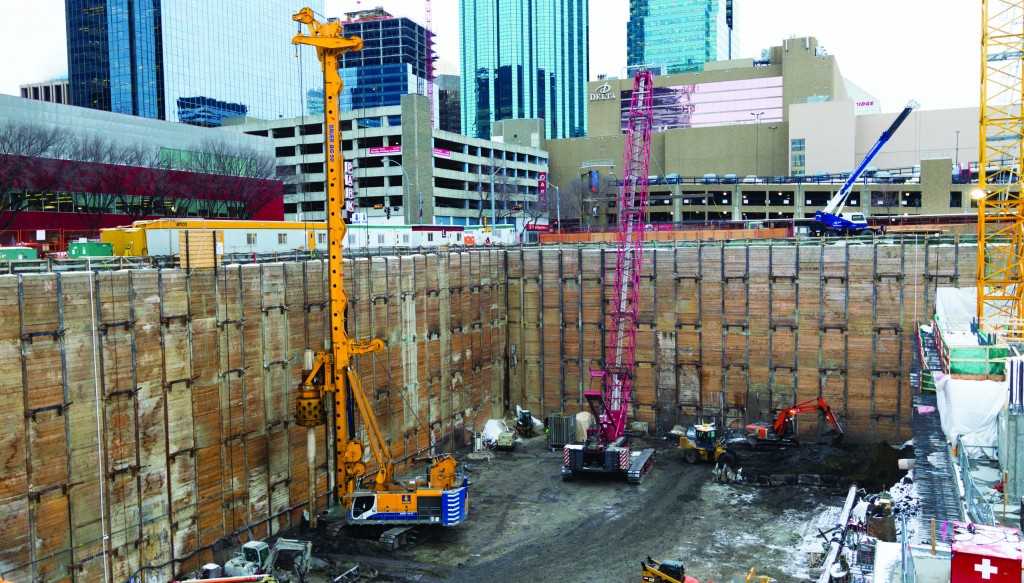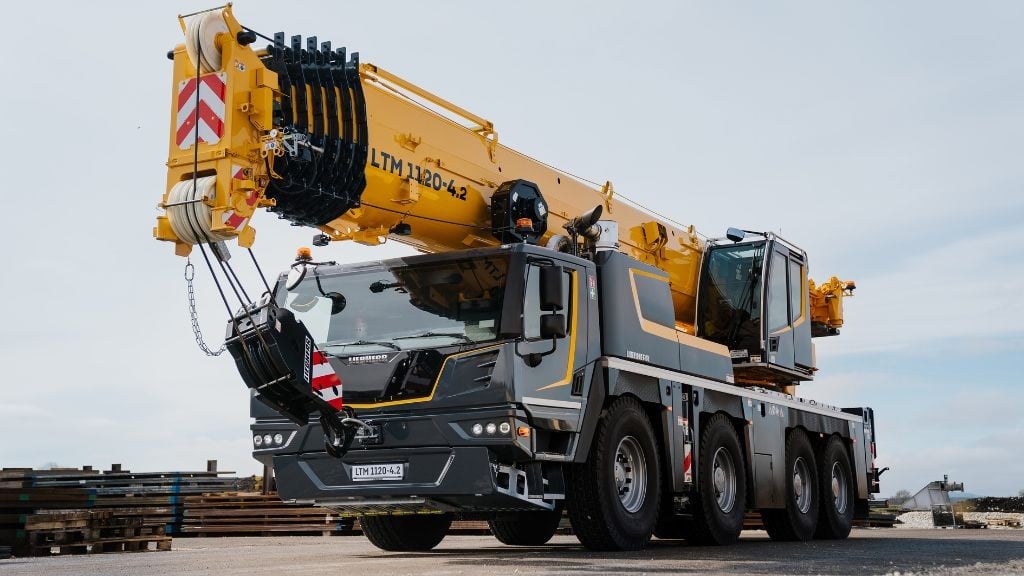Bauer's biggest rig drills deep foundation in tricky conditions for Western Canada's tallest tower
Caisson piles for ICE District project are deepest Bauer has ever done in Canada

A renewal is taking place in downtown Edmonton, Alberta, one that has taken an old warehousing area and is turning it into a shining new retail, residential and commercial hub for the community. The ICE District is a collection of towers being constructed around Rogers Place, the new home of the Edmonton Oilers; when completed, one of those towers will be the tallest in Western Canada.
Building any large structure in Edmonton is a tough job due to the geological makeup of the area; building a 60-plus story structure like the Stantec Tower is even more so, requiring a strong – and deep – foundation. For PCL, the general contractor for the ICE District project, an accelerated schedule and logistics made for a challenging project.
ICE District is a 25-acre space in the heart of Edmonton that, when complete, will include the arena, 300,000 square feet of retail space and 1.3 million square feet of offices – as well as condo developments and an upscale hotel. It's an ambitious project, and one that since it began has been on an ambitious timeline.
"The buildings were being designed as we were breaking ground, and a lot of the programming for the buildings was being established while we were getting into the construction," related Myke Badry, PCL senior project manager.
Work began on the site in 2014, and as the planning progressed, so did the size of the buildings. The Stantec Tower and JW Marriott hotel reached a point where a more robust foundation was going to be needed than originally planned.
"When the building started to reach heights upwards of 60 floors, we started getting into a situation where the ground pressure couldn't support the towers anymore and we had to work on a pile solution," Badry said. "So this is all happening while we were living in a hole . . . when we were about halfway down the hole we got directions from the design team to mobilize for caisson foundations."
Ground conditions on the site were, to say the least, interesting. The site had, over time, been built over, and in some cases the previous structures had been left on the site.
"At the time we got to the site it was a gravel parking lot with one building on it. When we were excavating it, we had to excavate the remnants of a lot of old buildings backfilled into the hole when the warehouse district was demolished several years ago," Badry said.
Below that, though, the team reached Edmonton's challenging geological underside: medium plastic clay and shale extending down some 75 metres below the site before reaching bedrock. Caisson foundations were the best option for providing the support needed by the Stantec Tower and its neighbouring hotel; the best option for drilling and installing the caissons, PCL decided, was to call in Bauer Foundations.
Deep drilling requires expertise
According to Badry, Bauer had the global experience and capability to get the job done in short order, as well as the equipment for what was a very deep drilling job.
"The pile depths go down to 75 metres, which is not normal anywhere in the world, and to add to that the piles had to be installed in an 18-metre-deep hole," said Allan Bowers, Bauer Foundations Canada operations manager. "We're also talking about reasonably large diameters – in this case, at 75 metres deep, we had 1,850-millimetre-diameter piles, so we had to bring in the biggest rig that Bauer manufactures, which is the BG50, a 260-ton machine."
Before tackling the actual drilling, however, Bauer's crews had to deal with a bigger challenge: getting to the site. Located as it was in the middle of a busy city, the ICE District project is congested to begin with. As Bauer mobilized its equipment, construction was going on all the way around the pit, making it doubly difficult to access.
"On the site itself, the towers that we piled are the only elements of the project that actually had foundation piles – the other elements are all on straight foundations. So, around our working area there was a car park being built adjacent and tower cranes in close proximity . . . the logistics of getting our equipment and materials in and out had to be managed," Bowers said. "The arena was also under construction just to the north of our site."
Close quarters coordination
That meant tight coordination with other ongoing work around the pit for movement of equipment in and out. It also meant that, with no ramp into the work site, the Bauer rigs needed some heavy lift cranes to get into the pit, and came with some assembly required.
"We had a 260-ton machine with 38.5-metre masts that had to be broken down into small enough parts to be lifted into an 18-metre excavation," Bowers said. "Obviously, it then had to be assembled at the hole, and at the end of the job we had to then dismantle it and lift it out. Lowering in and lifting out both required road closures, had to be done over weekends, and so forth."
Once the machines were in the pit, approximately a week was needed to reassemble them before work could begin; at the end of the project, they had to tear them down and lift them out again.
"All of this happened in the winter," Bowers added. "The work carried on right through the winter, in Edmonton, working 24 hours a day, six days a week."
Once the drills were in place, Bauer drilled test piles that helped finalize the design. Because of the sheer size of the structure above and the loads faced on the piles, the eventual decision on how many piles were needed took some time to complete.
"The tower was going to be around 250 metres high when it's finished, so obviously the loads were fairly sizeable," Bowers said. "We did a test pile to try and see if the design could be validated . . . that indicated that the soils were poorer than expected."
Piles are deepest Bauer has ever done in Canada
The completed design required 72 piles 1,500 mm in diameter and 52 metres in length for the Marriott tower, and 73 piles 1,850 mm in diamter and an impressive 75 metres deep for the Stantec Tower.
"Those were the deepest piles we've done in Canada. We've done more than 100 metres elsewhere in the world, so we knew we had the equipment and experience within the business," Bowers said. "We brought in the largest machine available within the group anywhere in the world. We had to have a special Kelly bar to get those depths – normal Kelly bar rigs are down to 40 metres deep. We were able to install these piles without the use of Kelly extensions, which meant the drilling time was faster than if we'd had to use smaller machines."
The BG50, which was used for the first time in Canada, and its higher torque were invaluable in drilling to depth, even with occasional surprises when more solid rock was encountered during the bores, Bowers noted.
With the caisson piles set to depth, the next challenge came with pumping each bore full of concrete. Logistics again became the limiting factor.
Each of the long piles required a pour of about 200 cubic metres of concrete. Bauer experts worked with the concrete supplier to get a concrete mix that would work with long pour times and the winter conditions - since the pours had to be done overnight from street level using a tremie system.
"The concrete had to be brought in when the traffic on the route from the concrete mix plant was not going to be congested – trying to do it during the day would cause issues with the concrete deliveries. We needed that concrete there as quickly as possible," Bowers said.
In all, PCL, Bauer and other contractors – with around 60 employees total on the caisson installation, and nearing 1,000 as tower construction got fully underway – put in about six months' worth of 24-hour work days to ensure that the ICE District project stayed on time. As of February 2018, construction is still ongoing but on target.
"For the Stantec Tower, we're on the 32nd floor of 69; the other tower, the J.W. Marriott, is on the 50th floor of 54," Badry said. "They're both targeted for occupancy in the third quarter of 2019." HEG




